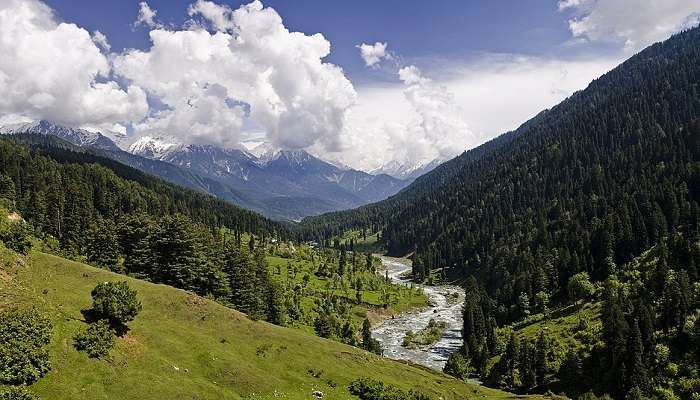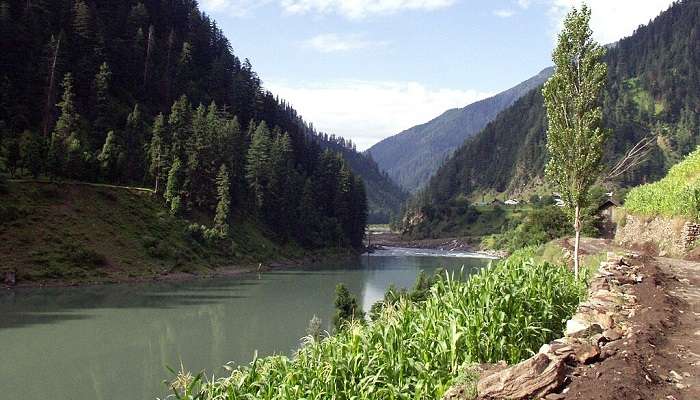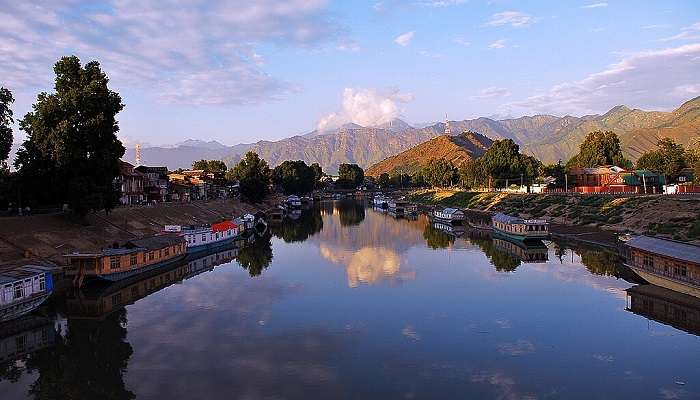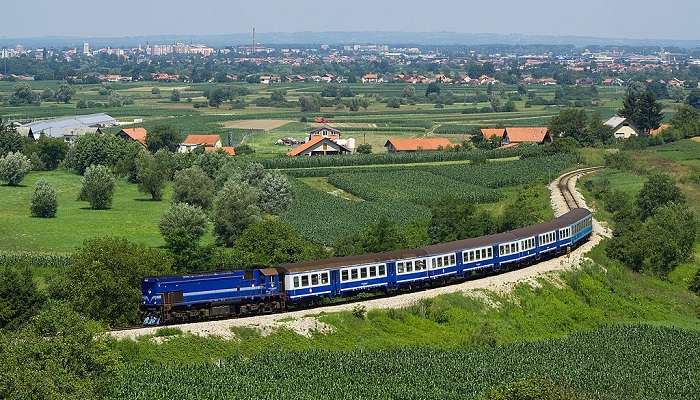Watlab Is A Charming Village With Unmatched Panoramas To Explore In 2025

Watlab is a quaint village in the Kashmir Valley of Jammu and Kashmir and lies at the highest point of the Jhelum river. It is an exceptionally breathtaking region famous for its unmatched natural beauty, pleasant weather, mountains covered in snow and outstanding views of the Wular Lake. And besides its natural splendour, Watlab is also renowned for its shrine that is dedicated to the Muslim mystic Baba Shukurddin. The region’s apple orchards are a delight to explore as well. Mostly untouched by construction, Watlab would be an excellent destination if you want to spend some time doing absolutely nothing.
Discover the Breathtaking Village Of Watlab
A must-visit destination for nature lovers and those looking for some time away from their busy lives, Watlab in Jammu and Kashmir should be at the top of your list. Here is everything you need to know about it to be able to plan the perfect trip:
1. A Glance At The Stunning Watlab Village

Nestled in the gorgeous Kashmir Valley in the union territory of Jammu and Kashmir, Watlab is a picturesque village that boasts immense beauty and tranquillity, serving as the ideal getaway from the hectic city life. It is located within the Baramulla district on the Sopore – Bandipora road and is a hidden gem worth visiting! The village offers spectacular views of the snow-covered mountains that you will remember forever. It is home to sprawling meadows, lush greenery, and apple orchards that simply must be visited.
The village lies on the Jhelum River, and not only that, it is a great place to catch some terrific views of the Wular Lake, which is also surrounded by small villages. The region is also known for its paddy fields which only add to its beauty and allure. And of course, no visit to Watlab would be complete without paying a visit to its revered shrine that is dedicated to Baba Shukurddin who was a Muslim mystic.
Must Read: Best Places to Visit in Srinagar
2. The Historical Significance Of Watlab

The region, as well as around Watlab, has been of great importance since ancient times. It was once a part of the Mauryan Empire under emperor Ashoka and was later a part of different dynasties, including the Guptas. Moreover, Muslim rulers from Central Asia also took control of the region during the Mediaeval times. The Kashmir region, including Watlab, was also part of the Mughal Empire under emperor Akbar as well as his successors between the 16th and 17th centuries. Due to this, local art and culture have elements of Mughal culture.
Two centuries later, during the 19th century, the Kashmir region, including Watlab, became part of the Sikh Empire when Maharaja Ranjit Singh captured it. However, the region was transferred to the Dogra dynasty in 1846 following the signing of the Treaty of Amritsar when the Sikhs lost control. It remained under the Dogra dynasty till 1947. Lastly, the independence of India and the consequent Partition brought about some turmoil in the Kashmir region. The then-ruler Maharaja decided to remain independent instead of joining either India or Pakistan but eventually decided to hand it over to India when invaded by tradesmen from Pakistan. This incited a conflict between the two countries, which is still ongoing. Due to this political tension, Watlab, along with other parts of the Kashmir region, has continued to experience some turmoil occasionally.
3. The Idyllic Wular Lake

One of the primary attractions in the area, Wular Lake, can easily be seen from Watlab. It is often referred to as Wolar in the Kashmiri language and happens to be one of the biggest freshwater lakes in the country and all of South Asia. Walur Lake is located in the Bandipora district of the union territory and is the result of tectonic activity. Its water comes from the river Jhelum and the streams Arin and Madhumati. The lake is mentioned in the Nilamata Purana and is called Mahapadmasaras. It is often also called Ullola since it tends to create giant waves in the afternoons; the word Ullola in Sanskrit translates to “high and stormy waves.” And lastly, it has come to be known as Wular Lake because it is said to have been created due to a gap or fissure. In the Kashmiri language, Wul means gap or fissure.
Wular Lake also has some historical significance. According to some records, the Kashmiri sultan Zain-ul-Abidin ordered an artificial island built in the middle of the lake. Other records suggest that the area around the lake was part of Raja Sundrasen’s kingdom, but owing to its many crimes, the lake is believed to have drowned him as punishment. What’s more, it is also of great ecological importance and is one of 80 Indian wetlands that have been deemed a Ramsar site. Moreover, the lake is home to many fish, including the Sattar snow trout, mosquitofish, Chush snow trout and rosy barb. Because of its vast fish population, the lake is an important fishing site and its catch makes for almost 60% of Kashmir’s fish yield. You might spot many kinds of birds here, like the Himalayan monal, Indian roller, barn swallow and Eurasian sparrowhawk. Lastly, the local government has also introduced boating and other water sports like water skiing here to encourage tourism.
Suggested Read: Kashmir Travel Tips
How To Reach

If you choose not to bring your own car, which would be the most convenient option, you can decide to either take the train or to fly here. However, both of these options would require you to book a taxi that would then bring you from the station or airport to Watlab. The nearest railway station is in Sopore, about 15 km away; it would take about 30 minutes to reach. On the other hand, the closest airport is in Srinagar, about 64 km away; it would take approximately 1 and a half hours to get from there to Watlab.
If you want to book accommodation in Watlab itself, there is only one option. There is a forest rest house here that is located within the apple orchards. It makes for a pleasant and scenic stay.
Further Read: Things To Do In Srinagar
You must now have a lot of information about Watlab and should be able to plan a great trip to this charming little village in Jammu and Kashmir. And with how much there is to see around this region, you could perhaps book a trip to Kashmir to enjoy all that it has in store for you. Don’t forget to book your tickets now so you and your loved ones can embark on an unforgettable journey!
For our editorial codes of conduct and copyright disclaimer, please click here.
Cover Image Credit: KennyOMG for wikimedia commons
Frequently Asked Questions About Watlab
Is Watlab very far from Srinagar?
No, Watlab is actually quite close to Srinagar. It only takes about an hour and 20 minutes to cover the 57 km between the two.
Which are the best months to visit Wular Lake near Watlab?
The best time to visit Watlab as well as Wular Lake is between the months of June and August when the weather is pleasant and cool. Moreover, this pleasant weather also means that the lake would be open for boating and other water activities.
At what time does the Wular Lake close?
The Wular Lake is open 24 hours so you can visit whenever you want. It is an especially beautiful place during sunset since the views are remarkable.
Is it necessary to take permission prior to visiting Watlab?
Although some areas in Kashmir are only accessible to visitors upon receiving permission from the local authorities for security reasons, that is not the case for Watlab or Wular Lake. However, if you plan on visiting other places during your visit, make sure to check whether you would need to seek permission or not.
Are there any other lakes worth visiting in Kashmir?
Absolutely, Kashmir is famous for its many lakes and some of the ones that you must visit are Dal Lake in Srinagar, Gangabal Lake in the Ganderbal district of Jammu and Kashmir as well as Mansar Lake in Jammu.
People Also Read:
Things To Do In Kashmir Places To Visit In Kashmir Hotels In Kashmir

Innovative Content Writer Focused on Producing High quality, Original Content that drives traffic and engages readers. Experienced in Content strategy and analytics to measure content performance using tools such as SQL, Power BI, Excel.











